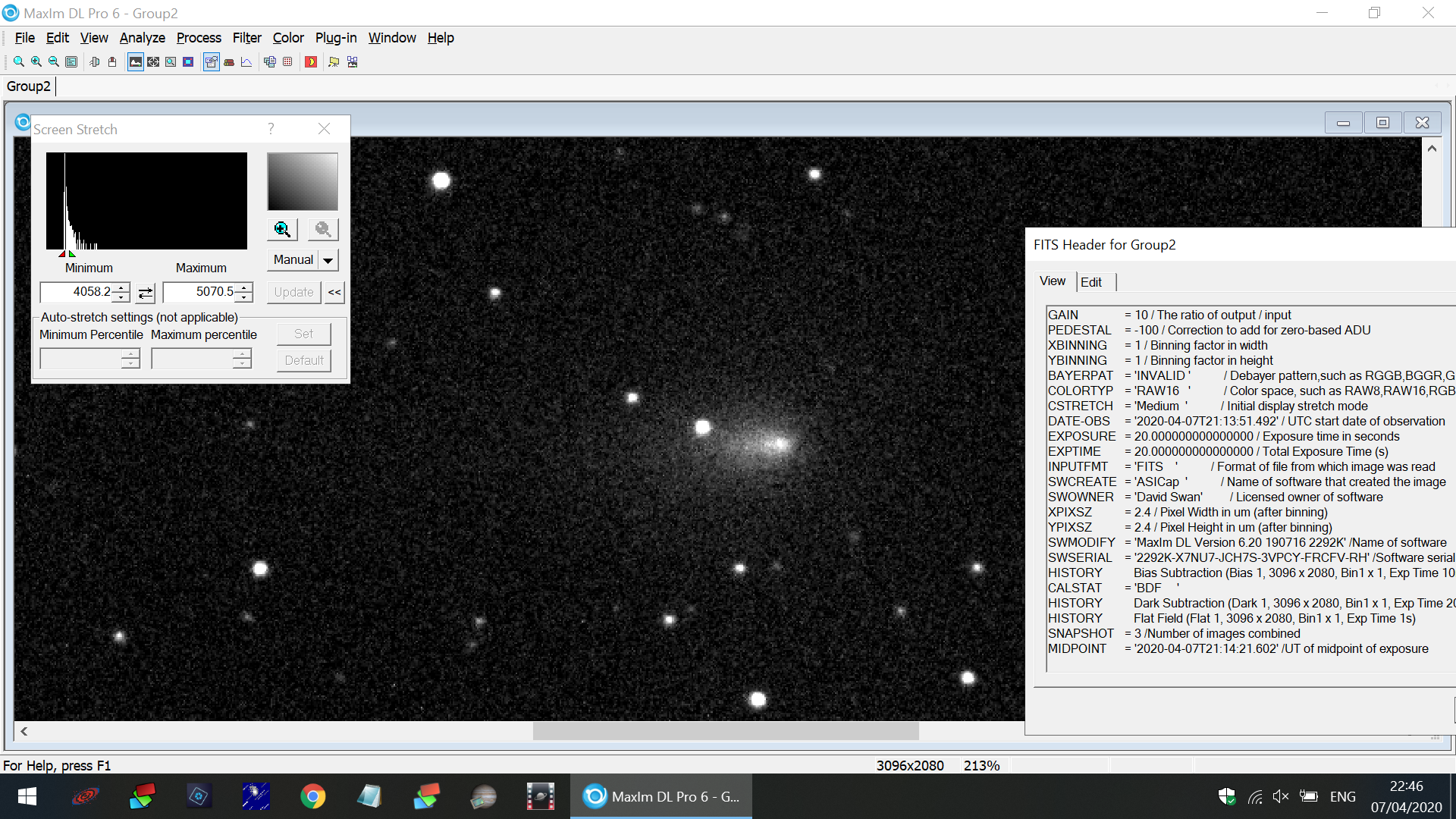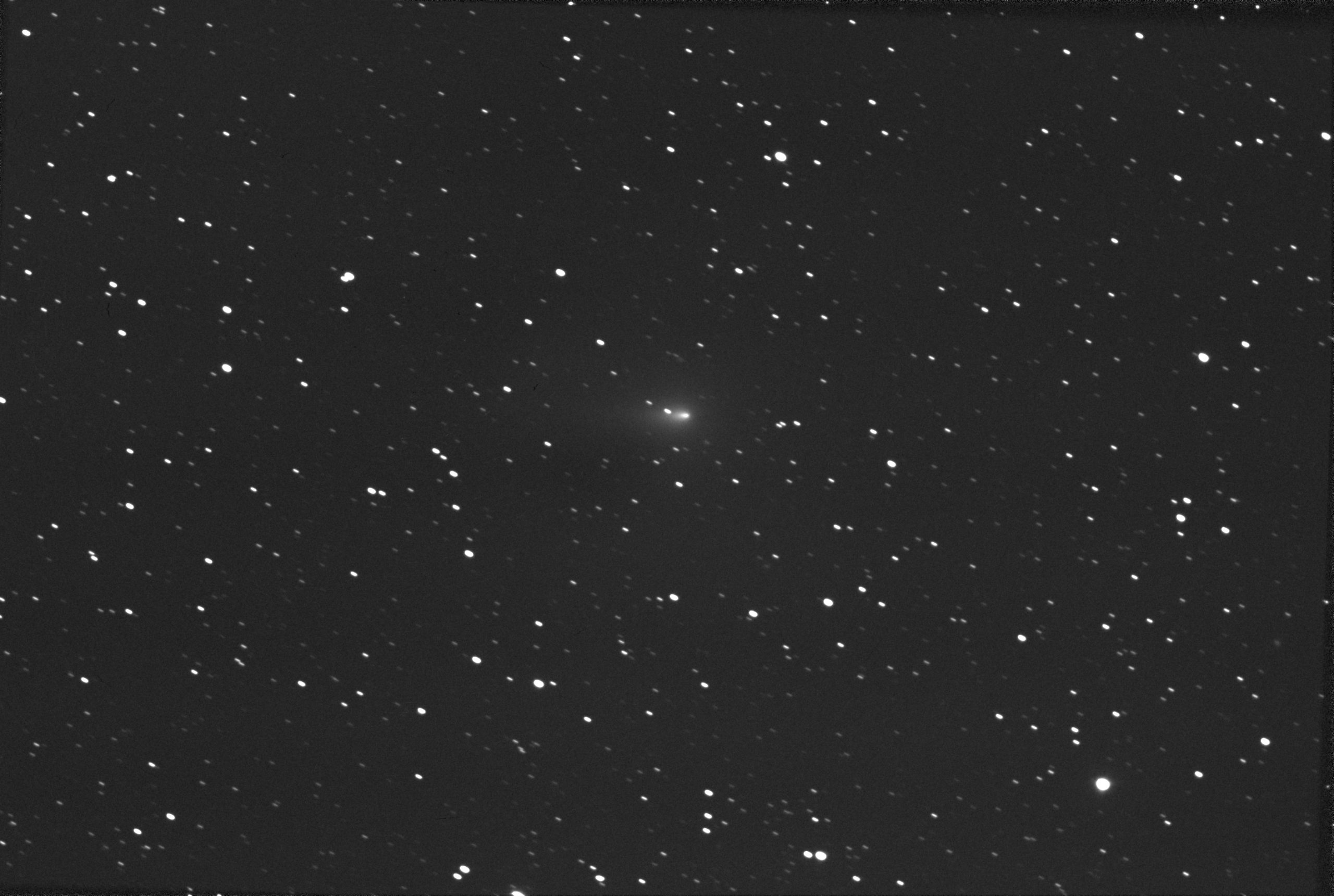- This topic has 16 replies, 6 voices, and was last updated 5 years, 7 months ago by
 Nick James.
Nick James.
-
AuthorPosts
-
7 April 2020 at 10:54 pm #574567
 David SwanParticipant
David SwanParticipantAs reported by Nick and many others, it looks like C/2019 Y4 is breaking up. Here is a very short 3 x 20s stack showing the broadness of the central condensation – and potentially multiple centres of density? I’ve plenty of subs – I just need to make sure I get the apparent motion right for the longer track and stack in Astrometrica. Additionally – 30 x 20s track and stack based on MPC parameters for Y4. Midpoint 2020-04-07T21:09:50 (UT).
8 April 2020 at 6:54 am #582242 Nick JamesParticipant
Nick JamesParticipantYes, I’m afraid C/2019 Y4 (ATLAS) looks as if it will soon be an ex-comet. Only a week ago I gave our first webinar talking about prospects for this object. Now I think it is probably a cloud of rubble. As Comet section Director I’m not having much luck with comets!
In my images over the last few nights I have not seen any fragments in the tail. What I have seen is a gradual reduction in the peak pixel ADU count and a flattening/broadening of the downtail coma brightness profile. This plot shows a cut through the photocentre aligned on the tail PA (positive offsets are tailward) for five nights from March 25 to April 7. You can see that peak pixel ADU falls from around 8000 to 1200 in that time (a fade of around 2 magnitudes) and the profile is broader with a more gradual tailward slope in the later images. It looks to me as if the nucleus has completely fragmented and what we are seeing is a cloud of rubble migrating down the tail. This explains the large astrometric residuals in RA since the photometric centroid is no longer aligned with the original nucleus.
If this is correct the future of this comet is as a fainter and fainter diffuse rubble pile. Let’s see what happens and keep this under observation as long as possible. We have a ringside seat to watch the distruction of a Solar System object.
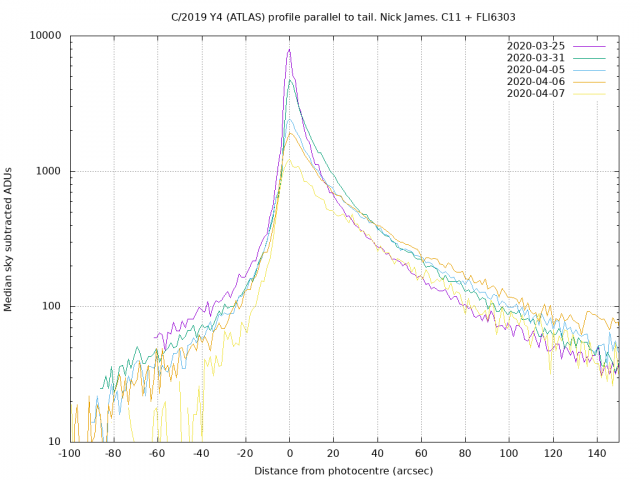 8 April 2020 at 2:38 pm #582243
8 April 2020 at 2:38 pm #582243 David BoydParticipant
David BoydParticipantThese two spectra of C/2019 Y4 (ATLAS) were taken on 26 March (blue) just before the recent disruption of the comet and on 6 April (black) after. Both were taken with a LISA spectrograph on a C11 and are integrations of 130 and 90 mins respectively. Reports indicate that the event has reduced the brightness of the comet by about a magnitude and it has become more diffuse. This was apparent from the increased difficulty in guiding on the comet in the later spectrum. The later spectrum also suffers from greater noise beyond that expected just from the reduced exposure time. However, it appears that the event has not introduced any significant change in the spectral profile of the comet.
 26 March + April 6 2020.png) 8 April 2020 at 10:20 pm #582244
8 April 2020 at 10:20 pm #582244 David SwanParticipant
David SwanParticipantIt has passed on! This comet is no more! It has ceased to be …and joined the choir invisible. THIS IS AN EX-COMET. (Well not quite.)
10 x 20s, not great transparency, 2020-04-08T20:50:20.164 /UT of midpoint of exposure.
9 April 2020 at 8:20 am #582246 Nick JamesParticipant
Nick JamesParticipantThat is very interesting, particularly the continuing strong C2 emission line. We now seem to have a cloud of rubble moving down the tail but the total magnitude is also falling which would imply that there was no sudden release of gas into the coma at the breakup. This implies that the comet had pretty much exhausted its volatiles before it broke up so we should now see the outer come fade and dissipate since it has no source at the centre. It would be good to follow this spectroscopically as long as you can.
9 April 2020 at 11:08 pm #582254 Nick JamesParticipant
Nick JamesParticipantThis image from tonight is at an image scale of 1″.29 per pixel with FWHM = 2″.9. It is an average stack of 57x60s frames with local flux subtracted using a 6×6 median. It is upsampled by a factor of 4 for display. There is a clear condensation to the NW of the bright extended coma. Interestingly, if you do astrometry on this condensation you get a position which is within 2 arcsec of the position predicted by the orbit using astrometry up to March 25. Current astrometry which is centroided on the bright elliptical coma is off by around 11 arcsec now. This condensation wasn’t visible in my images last night.
Is it what remains of the nucleus? We’ll find out over the next few days.
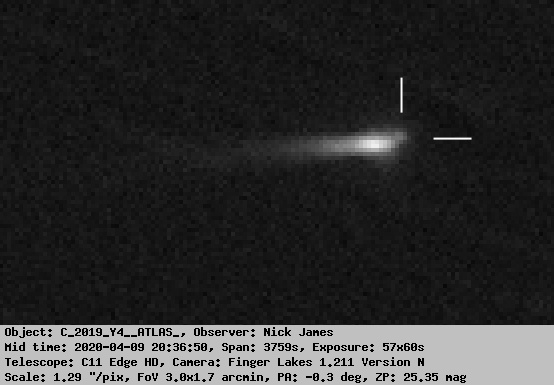 9 April 2020 at 11:26 pm #582256
9 April 2020 at 11:26 pm #582256 David StrangeParticipant
David StrangeParticipantThere were quite a few field stars interfering within the coma tonight – sure it’s not a star?
David
9 April 2020 at 11:50 pm #582257 Nick JamesParticipant
Nick JamesParticipantAbsolutely sure. This is a sigma-clip stack tracked on the comet’s motion. Stars will be faint streaks. Also this appears on multiple stacks always in the same position relative to the comet. And loads of other observers have imaged it…
10 April 2020 at 12:25 am #582258 David StrangeParticipant
David StrangeParticipantCongratulations! I’ve just seen Ernesto Guido’s gif animation, which is quite remarkable!
David
11 April 2020 at 9:40 pm #582261 Nick JamesParticipant
Nick JamesParticipantThe amazing run of clear nights continues combined with being at home every night means that I have imaged this comet on 7 consecutive nights now. This early stack tonight is an weak unsharp mask on the coma region showing the various components. The one to the top right (NW) is probably the residual nucleus.
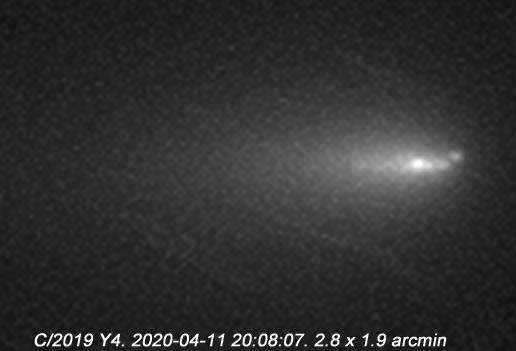 11 April 2020 at 11:45 pm #582263
11 April 2020 at 11:45 pm #582263 David SwanParticipant
David SwanParticipantThat is very impressive Nick. It is great to see those components – four fairly distinct ones. The sky was excellent this evening and I was pleasantly surprised with how – overall – C/2019 Y4 looked on individual subs, so I did a stack of 32 x 20s (2020-04-11T21:39:41 / Middle of exposure).
12 April 2020 at 11:03 am #582268 Nick JamesParticipant
Nick JamesParticipantNice image. Yes, it is still surprisingly good given all the turmoil going on in the centre!
13 April 2020 at 11:55 am #582274 Nick JamesParticipant
Nick JamesParticipantThe weather didn’t cooperate last night so I have no new images of C/2019 Y4 (ATLAS). I’ve been playing with images taken over the last few nights using FITSwork and iterative Gaussian sharpening (thanks to Nick Haigh for putting me on to this). These images show the development of the inner coma region over three nights. The first two were taken with by camera in 1×1 bin mode. Unfortunately I don’t have this for the last night so I have used a resampled versin of my normal 2×2 bin mode. All use the same Gaussian sharpening params (r=4.13, 20 iterations, 100% strength). You can see the components separating as the move relative to one another.
 14 April 2020 at 5:44 pm #582282
14 April 2020 at 5:44 pm #582282 Peter TicknerParticipant
Peter TicknerParticipantSkies were much clearer last night and I managed a stack of over two hours at 60 seconds and three main component parts can be seen as well as the tail debris around the original coma component.
Peter
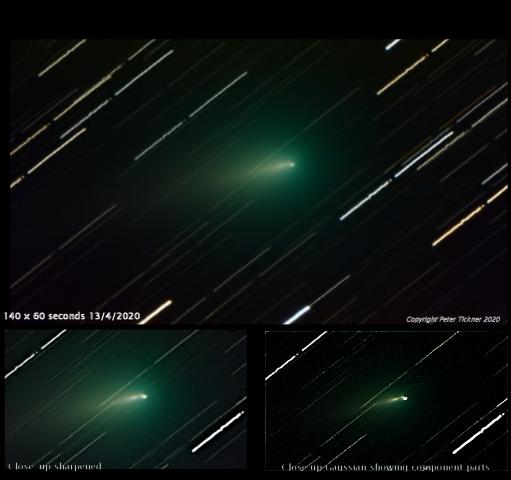 20 April 2020 at 6:48 pm #582321
20 April 2020 at 6:48 pm #582321 David SwanParticipant
David SwanParticipant[External link]
https://twitter.com/Yeqzids/status/1252256328841523200
Likely first glimpse at Y4 by the HST.
20 April 2020 at 7:11 pm #582322 Dr Paul LeylandParticipant
Dr Paul LeylandParticipantThis comet is no more. It has ceased to be. It’s a stiff. Bereft of life, it rests in pieces. It is an ex-comet.
21 April 2020 at 8:21 am #582324 Nick JamesParticipant
Nick JamesParticipantGreat image from Hubble. I have an image from Chelmsford taken 14 hours earlier and it is interesting to compare the two. You can see why having a 2.4m telescope in space is such a good idea. In three days time it will have been in orbit for 30 years. Let’s hope they keep it working for a long time to come.
-
AuthorPosts
- You must be logged in to reply to this topic.

